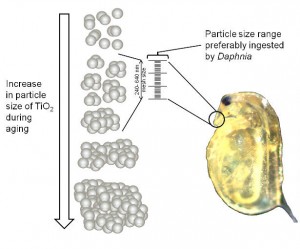In this post, Frank Seitz informs about their recent paper on the ecotoxicity of aged nanoparticles.
Engineered nanomaterials, as e.g. titanium dioxide nanoparticles (nTiO2), are heavily used and produced. That’s why their introduction in aquatic environments, for instance via wastewater treatment effluents, becomes more and more likely. There, those particles undergo different modifications over time, which are called “aging“. These modifications are likely influenced by environmental conditions, such as the presence of natural organic matter (NOM). During aging, the particles’ ecotoxicity for aquatic life might change in a yet unknown manner. Our study aimed at filling this gap by using nTiO2 aged under various environmental conditions as stressor and the acute as well as chronic response of the pelagic filter-feeding water flea Daphnia magna as measure for the nanoparticle related toxicity.
The data of our new paper show, that aging in absence of any ions doesn’t change the ecotoxicological potential of nTiO2 (independent of the aging duration), whereas their presence reduce their acute and chronic toxicity drastically (up to fourfold after 6 days). When including ions and NOM during aging, which represents an environmentally highly relevant condition, a reduced toxicity is observed for 6 days aged nTiO2 when compared to unaged material. However, same conditions increase the toxicity by approximately 30% when nTiO2 was aged for only 3 days.
Explanations for these observations can be related to the size development of the nanoparticles during aging. Because the particle size increases over the first few days of aging from below 100 nanometer (nm) to 500 nm (due to their agglomeration), the particles optimally fit in the size range of material, that can be ingested by filter feeding daphnids. However, when particles are aged for longer periods they may no longer be ingested ultimately reducing their effects on Daphnia.
Our findings highlight the currently existing knowledge gap regarding the underlying mechanisms and processes of nanoparticle-induced ecotoxicity. However, a respective understanding seems fundamental to predict the risks of nanoparticles in nature.
The freely available paper “Aging of TiO2 nanoparticles transiently increases their toxicity to the pelagic microcrustacean Daphnia magna” was authored by Frank Seitz, Simon Lüderwald, Ricki Rosenfeldt, Ralf Schulz, and Mirco Bundschuh and published in PloS ONE.

